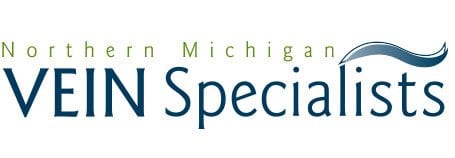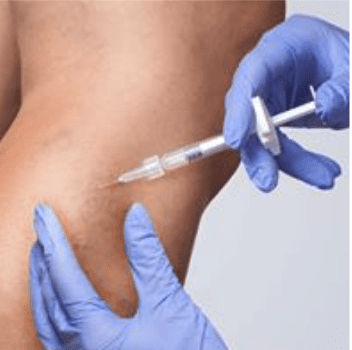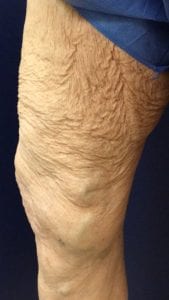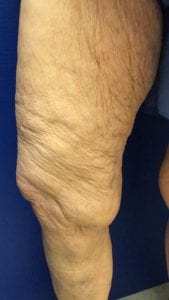Leg Spider Vein & Reticular Vein Treatment
at Northern Michigan Vein Specialists
What Is Sclerotherapy?
Sclerotherapy a treatment that involves the injection of a sclerosing agent indicated to treat uncomplicated spider veins and or reticular veins. Spider veins are a very small reddish, blue twisted blood vessel which may be scattered, isolated to one area, or appear in clusters. Reticular veins are larger than spider veins and appear as a bluish-green vein.
Does Sclerotherapy Hurt?
Sclerotherapy involves the use of a very small needle to inject the sclerosant agent into the diseased veins. The solutions work by causing the veins to shrink, close off, and gradually disappear.
The needles used at Northern Michigan Vein Specialists are very small and feel like a mosquito bite. Most people find this relatively painless.
Who Is A Candidate For Leg Vein Therapy?
The vast majority of adults who want to eliminate spider veins and varicose veins can benefit a great deal from a custom vein treatment plan. Some information that is found online states that the best candidates for vein treatments are aged 30 to 60. This can sound exclusive to older adults who are struggling with the consequences of venous insufficiency. If you are older than 60 years and you are in good general health, do not have a bleeding or clotting disorder, and can follow post-treatment care guidelines, you may still be a good candidate for the vein therapies that are available today. Before recommending any vein treatment, your specialist will conduct a thorough examination, consultation to discuss expectations, and a comprehensive medical history review. It is our intent to provide the highest standard of care to our patients. If you are interested in getting rid of uncomfortable varicose veins or spider veins, contact us today for a personal consultation.
How Long Does It Take For Legs To Heal After Sclerotherapy?
The recovery from sclerotherapy is relatively short. Patients are often able to return to work and light physical activity 3 to 5 days after the procedure. It is important to avoid strenuous activity and excessive heat for the first few days of recovery and to wear compression stockings as directed in our post-treatment instructions. Though comfort may improve significantly in this timeframe, the cosmetic aspects of sclerotherapy can take longer to resolve.
How Long Does It Take To See Results After Sclerotherapy?
Sclerotherapy works by closing veins so blood cannot pool and cause visible and invisible symptoms. Once the vein collapses, the body will recognize it as unviable and will absorb it. This process occurs naturally over the course of about six weeks. Sometimes it can take longer for the remnants of the vein to completely disappear. Patients may begin to see their once-problematic veins lighten three to four weeks after their sclerotherapy procedure. It is also important to understand that, in some cases, sclerotherapy must be repeated to fully eradicate the visible symptoms of varicose veins.
Can I Combine Sclerotherapy With Other Procedures?
Yes. Patients sometimes present with multiple vein issues at one time. To address each, we develop a comprehensive treatment plan that may combine a few different modalities. The objective of vein treatment is to eliminate the venous insufficiency that is causing problems like spider veins and varicose veins. Treatments are performed to reduce uncomfortable symptoms and improve the appearance of the legs. As an example, spider veins may be treated with sclerotherapy, while deeper veins experiencing reflux may be treated with radiofrequency ablation. Some varicose veins may respond well to non-thermal therapies like VenaSeal. Some may need more comprehensive vein treatment like ambulatory phlebectomy. The advantage of receiving care from a vein specialist is that they have the various modalities that are necessary to meet broader venous insufficiency in a safe, effective manner.
What Are The Side Effects Of Radiofrequency Ablation?
Complications are quite rare, but there is a possibility of deep vein thrombosis; this can occur in any procedure where a catheter is placed into a vein. Nerve damage to sensory surface veins is possible, but these nerves usually return to normal in a few weeks to a couple of months.
Benefits Of Endovenous Laser Ablation (Vein Laser Treatment)
- Relief of symptoms
- Less invasive; not a surgical procedure
- Little downtime
- Same day, outpatient procedure
- Little to no scarring
Who Is A Good Candidate For Endovenous Laser Ablation?
As with radiofrequency ablation, just about anyone bothered by their varicose veins is a great candidate for endovenous laser ablation. Dr. Heeringa advises patients to exhaust conservative treatment options — wearing compression stockings, losing weight, exercise (particularly with your legs), and elevating your legs while sitting — before opting to have Endovenous Thermal Ablation.
The Endovenous Laser Ablation Treatment
Endovenous Laser Ablation uses laser energy, which is simply a highly concentrated beam of light. Medical lasers work by delivering this light energy to the targeted tissue with extreme precision, so as not to affect the surrounding tissue. Lasers have proven their safety and effectiveness through years of use in all types of medical procedures, from eye surgery to dermatology. In the hands of a skilled physician, lasers offer far less risk for complications than conventional surgery.
In Endovenous Thermal Ablation, a thin fiber is inserted into the damaged vein through a tiny entry point in the skin. Using ultrasound technology, a thin laser fiber is guided into the vein through a very small opening to deliver pulsed laser heat to the diseased vein wall. This causes the vein to close and seal shut and eliminates venous reflux at its source. The veins that are closed are superficial veins that handle less than five percent of the body’s blood flow. The blood is automatically routed to other, healthy veins.
Some physicians are now using a jacketed fiber, which prevents any contact between the fiber and the vein wall. The jacketed fiber prevents much of the pain and bruising that is often associated with the most conventional method of ligation and stripping. Some patients may experience temporary soreness or some slight swelling, which can be treated effectively with over-the-counter, non-aspirin pain relievers, and typically subsides within 1 to 2 days. Possible complications of endovenous laser treatment are thermal skin burns and transient numbness.
Both Radiofrequency ablation and Endovenous Thermal Ablation procedures are an alternative to more invasive leg stripping surgery that requires hospitalization and general anesthesia. Radiofrequency ablation and Endovenous Thermal Ablation are used primarily to treat the great saphenous veins (GSV), small saphenous vein (SSV), and other superficial veins in the legs. Varicose veins that branch off from these blood vessels are treated with Sclerotherapy or Ambulatory Phlebectomy.
Will I Need Time To Recover After Endovenous Ablation?
Following your treatment, we’ll put you in a gradient compression stocking to help reduce bruising and tenderness and to minimize the rare possibility of blood clot formation. The pressure also helps the body start going about the process of absorbing the closed-off vein. This is important for the vein to fully vanish from view. You’ll wear these compression stockings for two weeks.
You can return to normal activities and work immediately. Moving about is important. Pretty much the only thing you shouldn’t do is get on a plane or anything involving prolonged sitting, such as a car trip. You’ll have to avoid long-haul flights for at least 3-4 weeks. Staying active is the best way to avoid the risk of developing blood clots.
How Long Does An Endovenous Laser Ablation Treatment Take?
Endovenous laser ablation takes just 20-30 minutes per leg.
Are The Results Of My Endovenous Laser Ablation Permanent?
The veins closed off by Dr. Heeringa with Endovenous Thermal Ablation are permanently closed. They won’t return to pumping blood, so they then cannot become varicose veins either. Most veins treated with laser ablation are effectively invisible, even to ultrasound, 12 months after the procedure. There isn’t any scarring with this procedure, and there is little, if any, discomfort. The treated vein will not return. Of course, you can still develop other varicose veins in the future.
What Are The Possible Side Effects Of Endovenous Laser Ablation?
As with any procedure where the skin is penetrated, there is a slight risk of injection, but this occurs in less than 1 in 1,000 cases. Since the catheter is inside the blood vessel, there is a risk of damage to the blood vessel, bruising or bleeding at the puncture site, and infection. The experience of Dr. Heeringa and our team at Northern Michigan Vein Specialists mitigates this risk.
Patients often have some post-procedure bruising and tenderness. Your compression stockings help to ease these effects.
Thrombophlebitis (swelling of the vein) is not uncommon, and this can cause pain and tenderness over the treated area. Most patients only need over-the-counter anti-inflammatory medication and ice to handle the pain.
There is an extremely low risk of a pulmonary embolism where a blood clot forms in the vein and can travel to the lungs.




